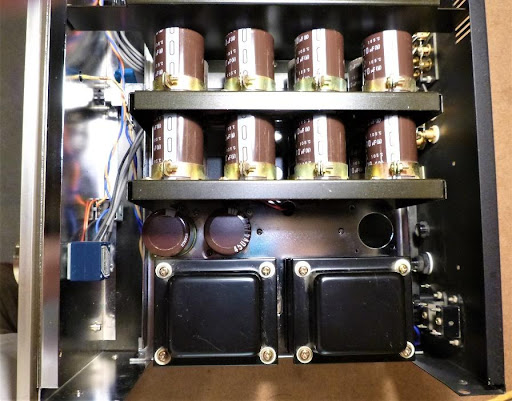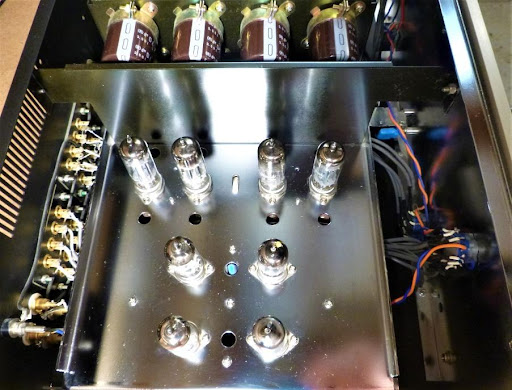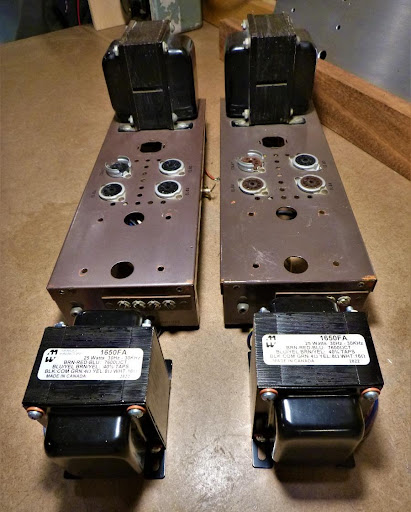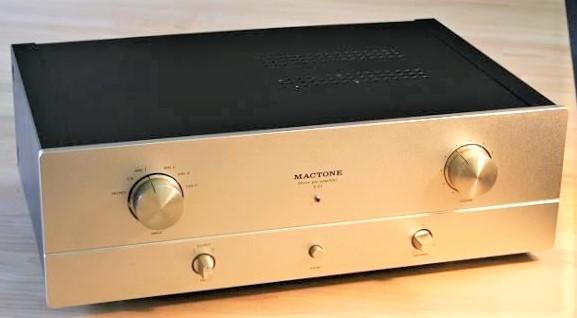Ace and Steve’s Big Vintage Summer Adventure:
Update No. 3: The Long and Winding Road
by Steve Graham
Progress of a sort, on the Mactone front. Perfect and as new? Probably not. The conundrum one can face with obscure vintage gear, like the X-21, is finding reliable and reasonably complete information.
I had a hard time wrapping my head around the X-21’s circuit. Not having a schematic, a fair bit of time was spent looking, head scratching and making voltage measurements. The power supply wouldn’t look out of place in a pair of stereo EL84 power amps. There are eighteen large capacitors filtering the B plus voltage! All of these capacitors retain the almost 400 volts B+ long after turn-off. The X-21 could have a fatal bite for the unwary.
PLEASE READ THE FOLLOWING IF YOU HAVE A MACTONE X-21
Safety notice: If you are thinking of working on it, be very careful. If you are unsure of what you are doing, DON’T DO IT! The high voltage supply is almost 400 volts! All of the capacitors seen in the picture below store a lot of energy and do so for more than an hour after the X-21 has been switched off. Use a multimeter to check the B+ voltage before proceeding. If only changing tubes, be careful of the capacitor bank wiring exposed with removal of the top cover.

Mactone took a much different tack than preamps built in the ‘50s and 60s. The Fishers, as well as Leaks and Quads of that era (and many others) “stole” power from their matching power amps. The X-21’s power supply is the diametric opposite, with vastly more than sufficient B+ current and filtering. Some might call it overkill. But as Mae West said, “Too much of a good thing can be wonderful!”
I tamed the filament voltage a bit for longer tube life, and replaced a pair of marginally-rated filter capacitors in that supply as well. Also, the AC input-side wiring was brought up to current electrical code. Virtually all internal components are first-rate and look to be in decent shape. The Mac wears its age well.

The line section circuit is quite simple; a single anode follower gain stage, but with a couple of twists. Two tubes, per channel, each with two triodes per tube (a total of four triodes per channel) are connected in parallel for better current drive, lower noise and lower output impedance. Conrad-Johnson used a similar approach in their ART series of line stages. As well, the tubes have a negative bias voltage applied to their grids similar to a fixed bias power amp’s output tubes. (learn more about tube biasing) This has the potential advantage of running the tubes in the most linear part of their operating range. The downside is that more capacitive coupling is required to isolate each gain stage from adjacent stages, and from the volume control.
Like the line section, the phono amp has all of its tubes biased with a negative grid voltage too. The first gain stage has two triodes in parallel. The second and third stages, which incorporate the RIAA equalization, are single, non-paralleled, triodes.
So how does it sound? On brief, semi-critical listening, the line section seems tight and dynamic, but not a bit harsh or strident. As far as the phono section goes, I can only equivocate. The truth is, I haven’t listened to vinyl in such a long while that I don’t quite trust my ability to judge. I did however, play some digitally-sourced music through the phono section with the aid of an inverse RIAA device. Like the line section nothing stood out as being obviously bad.
The line section seems silent as far as I can tell. At silly-high volume settings the phono section does have some hiss. Not having a schematic and not knowing what to expect from the circuit, voltage-wise, I’m at the limit of what I can achieve with the X-21.
The editor and I live about a three-hour drive apart. It’s not a straightforward trip and entails either big-city congestion or circuitous back road plodding. We agreed to meet half way along the back road route.
We hadn’t met face to face, in what we were guessing, was about four years. Time flies, even if you aren’t having fun. I’d missed conversation of even the geeky audiophile sort. At about half an hour, our time together seemed too short. We had to be on our respective ways. But our meeting had a purpose besides mere chit chat. I transferred the Mactone to Noam and he gave me transformers! Yes, Ace had decided to forge ahead with rebuilding the Fisher amps (actually, I’ll be the one doing most of the forging). The boss used his industry contacts to secure a pair of Hammonds to replace the dead Fisher output transformers.
The Fishers will be, as the car guys say – purists, grab something solid – a resto-mod. Sure, they won’t be true Fishers, but two at least decent, possibly even very good-sounding, mono amps should be the result. I get it, they won’t be original but they will play music and that’s what matters most, isn’t it?

With respect to the Mactone, the boss had a more serious listen than I did and reports that the line section is excellent, phono performance wasn’t as good as expected. It seems there is still some uncertainty as to what actual tube types are used in the phono section. The quest for reliable information continues.
Next time. Expect some news on the Fishers very soon. They are up, running and undergoing their break in cycle as I write this.
The Leak Stereo 20 awaits my attention. No progress to report before September at the earliest. I haven’t quite decided how I will attack the hum problem reported last time. I have a feeling it might not be pretty. Purists: relax, I won’t change the circuit. However, layout of the ladder board and other wiring is under intense scrutiny.


Hi Steve. There’s one of these Macs up for sale on Canuck Audiomart with a photo of literature listing the tube complement:
https://www.canuckaudiomart.com/details/649901571-mactone-x-21-japanese-all-tube-preamplifier-price-drop/
I have it listed for sale (for Ace). But the tube listing on that sheet is for the domestic version of the X-21. I’ve reached out to numerous parties for confirmation.
Noam
Thank you for your comment Mr. Bucksath.
To clarify what my long-suffering editor means, the domestic version is the Japanese version. The 6C45P tube is a single triode with a 6-volt filament. The phono section of the X-21 is wired for two dual triodes per channe6l. The filament supply is 12 volts. The first stage has the filaments of two 6-volt tubes connected in series (one tube for each channel). The second and third stages use a dual triode 12-volt tube, one tube per channel.
I hope this helps.
Steve Graham